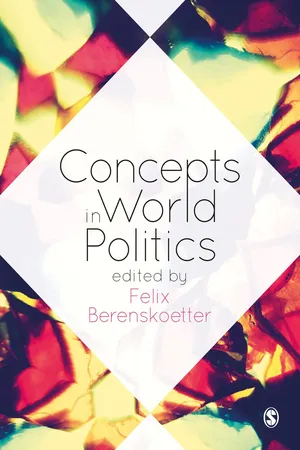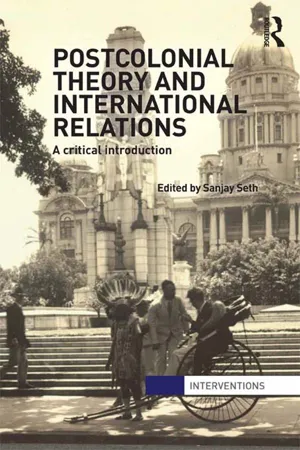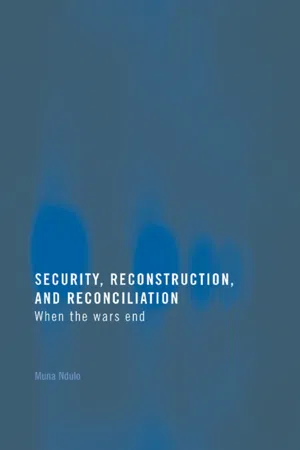Social Sciences
War and Conflict
War and conflict refer to organized and often prolonged violent confrontations between different groups or nations. These events can have significant social, political, and economic impacts, often resulting in loss of life, displacement of populations, and destruction of infrastructure. Understanding the causes, dynamics, and consequences of war and conflict is a key focus of social sciences.
Written by Perlego with AI-assistance
Related key terms
7 Key excerpts on "War and Conflict"
- eBook - ePub
- William Outhwaite, Stephen Turner(Authors)
- 2017(Publication Date)
- SAGE Publications Ltd(Publisher)
As we see, the generic concept of war has taken on many meanings and connotations that still shape its use today: it can be seen as a state of hostility (which partially justifies the notion of Cold War), as a practice of large-scale organizational violence (hence the ministries or departments of war in charge of preparing and organizing this category of statecraft), as a relational process linked to reciprocal enmity (war as a dialectic of wills) and as a set of recurring yet singular historical events (first world war, second world war). All of these dimensions come together in our archetypical representations of war.While the use of the concept of war would maybe be more precise if restricted to situations in which all these dimensions are simultaneously present, such a move would also entail significant risks of ethnocentrism: the strict distinction between the battle and war, the institutionalized rules of war and their violations, times of peace and times of war, political and military units and so on are all but universal (Keegan, 1993). This is arguably the main reason for which many quantitative scholars prefer terms carrying less historical connotations such as ‘armed conflict'. One can however also interpret this multidimensionality flexibly, by considering these connotations as part of the contemporary legacy of war and hence as virtually present (but not necessarily actualized) in current strategic thinking and practice (Bonditti & Olsson, 2016). Moreover, there is no denying that the discrepancies between the subjective representations and objective realities of war are a central aspect of the object itself rather than a purely contingent feature of war (Barkawi & Brighton, 2011).While not reducible to organized reciprocal violence between political groups, we will however here consider the latter element to constitute the most stable and central aspects of war.War, Violence and Conflict
To the limited extent that war is dealt with in sociology, it is often through related terms such as conflict, organized violence or collective violence (Joas & Knöbl, 2013). We therefore want to build on these concepts to situate war both as a specific phenomenon (at least as ideal-type) and as part of wider conceptual continua.Let us start by situating war in relation to conflict. War in principle unfolds in the context of a wider conflict understood as a relation of reciprocal opposition between two or more actors leading to strategic interactions between them. Conflict might arise when social agents pursue incompatible objectives, but it nearly always is also tied up with relationally constituted identities, identities defining Self in relation and in opposition to Other. By no means do conflicts need to involve physical violence. Most conflicts, from labour conflicts to conflicts between political party-leaders in democratic systems, are usually non-violent. At the same time, violence can erupt independently from any pre-existing conflict for example in the case of genocide, one sided assaults etc. There is however an elective affinity between conflict and physical violence. Indeed, among the ways in which a conflict can be settled (negotiation, arbitration, court ruling, flipping a coin), physical violence is the only that does not suppose a basic trust that the Other will stick to commitments (Vasquez, 2009). In this paradoxical sense, war can also be seen as a last-resort mechanism of conflict-resolution when all other such mechanisms have failed (Holsti, 1996; Luttwak, 1999). - eBook - ePub
- Patricia J. Campbell, Aran MacKinnon, Christy R. Stevens(Authors)
- 2011(Publication Date)
- Wiley-Blackwell(Publisher)
For example, The Stanford Encyclopedia of Philosophy defines war as “an actual, intentional and widespread armed conflict between political communities.” 15 In this framework, the term “political community” could include both states and those that intend to become states, such as a rebel organization fighting a civil war. This definition could also potentially include conflicts between states and terrorist groups, since some terrorist groups can be considered “political communities,” particularly when their activities are designed to achieve or influence the development of statehood. 16 While this definition includes more entities than states, it nevertheless creates additional parameters that circumscribe the types of conflicts that can be described as “war.” There are broader definitions still that attempt to account for many of the violent conflicts that traditional definitions of war exclude, including undeclared military actions, conflicts between non-state peoples, ongoing terrorist campaigns, guerrilla uprisings, wars without a central controlling body, and wars without a clear beginning or a clear end. 17 For example, the miniAtlas of Human Security defines war as any armed conflict with over 1,000 battle-deaths in a year.” 18 While this definition of war is broader, in that it is not contingent upon the status of the combatants, it also applies yet another specific condition that had heretofore not been considered: the number of battle-deaths. While 1,000 deaths may well seem like an arbitrary number, it nevertheless poses the question “What is the relationship between war and casualties?” Can a conflict without or with very few casualties accurately be called a war? Types of War and Violent Conflict Inter-state and intra-state conflicts If war is defined as an intentional and widespread conflict that occurs only between states, then war is always international in scope - eBook - ePub
- Felix Berenskoetter(Author)
- 2016(Publication Date)
- SAGE Publications Ltd(Publisher)
This chapter will first consider the task of providing a formal definition of war that might pare down the phenomenon to its essential traits, thereby underlining the inherent limitations of any purely abstract conceptualization. In a second step, it will examine the specific conception of war that emerged alongside the Westphalian international order and informed the practice of armed conflict between states for several centuries. Despite its predominance, this state-centric bounding of war has not been without historical tensions and challenges that the chapter will then turn to. Finally, it will consider the present, and perhaps terminal, crisis of the Westphalian understanding of war in the face of the complex contemporary manifestations of armed conflict.Conceptualizing War
While it is possible to devise a social scientific definition of war as organized violence perpetrated for political ends, such a conception remains decidedly broad and indeterminate until it is related back to the specific usages and meanings invested in it within the sociocultural practices of armed conflict. Central to these practices are the delineations and attendant legitimations that draw distinctions between various manifestations of political violence and set the parameters of conduct of the activity referred to as war. Or, as Michael Walzer puts it:War is not usefully described as an act of force without some specification of the context in which the act takes place and from which it derives its meaning […] the social and historical conditions that “modify” war are not to be considered as accidental or external to war itself, for war is a social creation […] What is war and what is not-war is in fact something that people decide. (2006: 24)The conceptualization of war is thus inevitably intertwined with its own practice and enmeshed within a wider constellation of significations and material forces. It is therefore necessary for us to pay particular attention to the specific institutionalization of war as a regulated means of punctuated intercourse between sovereign peers that was historically realized under the Westphalian state system, since it is that to which we still owe our dominant mental conceptions of armed conflict. Only then can we grasp the ways in which new expressions of organized violence have rendered this conventional understanding of war increasingly untenable, opening up its concept to renewed intellectual scrutiny. - eBook - ePub
Postcolonial Theory and International Relations
A Critical Introduction
- Sanjay Seth(Author)
- 2013(Publication Date)
- Routledge(Publisher)
Strategy concerns how to prevail in war, and more broadly how to use military force among other instrumentalities to achieve political ends. The study of strategy is not the study of war per se, nor does it amount to a social science adequate to the ‘phenomenon of war’ as a totality, however essential an understanding of strategic thought would be to such a science. More generally, the problem is that no social science discipline takes war as its central object of analysis, as in the case of politics, society, economy or culture, each of which have their own cognate discipline. In the absence of a discipline, war itself is not centred as the object of analysis and debate, as itself the focus of a continuing scholarly conversation. At issue are the concerns of some other scholarly conversation, such as the relationship between war and state building, the effects of war on public opinion and elections, the war proneness of the international system, the legality or ethics of war, or the consequences of war for society. Of course we learn much of war through studies of these and other kinds. Historians, sociologists, peace and conflict studies and feminist scholars have all made seminal contributions to the study of war, however conceived, but the point here is that such studies have not developed into and are not conceived as a body of inquiry oriented to the problematic of war as the central object of inquiry. 7 What war consists of is most often taken for granted, usually as the clash of arms, and is addressed only in and through the terms of a discipline or scholarly project principally devoted to some other subject. In other words, war is reduced to another social domain. War appears as a builder of states in historical sociology, a pattern of public opinion in political science, an effect of the international system in international relations scholarship, or a disrupter of personalities in literature and psychology - eBook - ePub
Understanding Civil Wars
Continuity and change in intrastate conflict
- Edward Newman(Author)
- 2014(Publication Date)
- Routledge(Publisher)
The scope and objectives of civil war studies remain contested. There is disagreement on how to understand and explain civil war, what the object of study should be, and what constitutes reliable knowledge. Scholars and analysts interested in intrastate conflict are defined and divided by their epistemological worldview and methodological approaches. Attempts to categorize intrastate conflicts and identify patterns are fraught with difficulty. The role of a wide range of variables – such as ethnicity, poverty and inequality, culture and religion, regime type, demographic factors, environmental factors, regional insecurity, resource scarcity and abundance, amongst others – in explaining the onset and nature of civil wars remains controversial. 1 More fundamentally, there is disagreement on the political and societal significance and meaning of such conflicts – or indeed whether there is any such significance in the contemporary era – and whether intrastate conflict and civil wars are changing in nature. 2 The volume also explores a number of arguments related to the nature of armed conflict. Some scholars have argued that armed conflict is fundamentally changing in nature, and that contemporary civil wars reflect 21st-century forces of globalization, identity, transnational networks and state failure. In this context military tactics, the role of technology, ideas of victory or defeat in war, and the way that conflicts are understood seem distinctly contemporary. 3 Other scholars have argued that intrastate conflicts are the criminalized, anarchic remnants of war, devoid of political meaning. 4 Rupert Smith suggests that war – industrial war as a major deciding event in international affairs – no longer exists. 5 What we have instead is war amongst the people, which does not qualify as war within the old frame of reference - eBook - ePub
International Relations
A Beginner's Guide
- Charles Jones(Author)
- 2014(Publication Date)
- Oneworld Publications(Publisher)
politics of war, conceived of as a deliberate act of state, than with its conduct or reality.Statistical work of the sort attempted by CoW researchers requires careful coding of information. This in turn requires clear definitions, not just of war but of possible explanatory variables such as regime type or arms expenditure. Make the requirements too tight and the number of cases becomes too small to justify meaningful statistical analysis. Relax the criteria in order to secure a larger number of cases, or universe, and any statistically robust results may fail to apply to current cases because the world has changed since the research project was designed.Ways of War
The original aim of the CoW project was to ascertain the causes of inter-state war, but even those conflicts captured by its standard definition have varied enormously in character from one decade to the next and, within the same conflict, from one theatre or phase to the next. Wars are complex and mercurial, comprising sieges, skirmishes, and raids. The archetypical expression of war is battle. Once upon a time the battlefield was just that: a field. By the end of 1914 a battle could be launched along a sector, several miles long, of a front extending several hundred miles. The defensive strength of such fronts was broken, twenty-five years later, by deep armoured thrusts that allowed defensive lines to be attacked from flank and rear until encircled, or kettled. The notion of a front more or less vanished as Russia rolled with German punches in 1942 and 1943 and long-range bombers pounded European cities deep behind the lines. Some wars require conscription; others are fought exclusively by professional volunteer forces. Some, such as the 1982 conflict between Britain and Argentina in the South Atlantic, take place far from major population centres; others have massive implications for civilians, whose sufferings may range from deprivation, mobilization, and bombardment at home to displacement, theft, rape, and massacre in areas of ground conflict. - eBook - ePub
Security, Reconstruction, and Reconciliation
When the Wars End
- Muna Ndulo(Author)
- 2007(Publication Date)
- UCL Press(Publisher)
Part I The social, political, and economic dimensions of conflict
Passage contains an image
1 Arms trafficking and the local political economy of conflict
William RenoIntroduction
An influential United Nations report argues that the proliferation of small arms and light weapons plays a major role in promoting violent conflicts. It shows how groups that previously would have been inclined to settle their differences through negotiations or other nonlethal means now find more options to arm themselves.1 The increasing availability of hardware “demilitarizes war” in the sense of enabling quite small groups, not just state militaries, to organize for combat.2 Thus easily available small arms help to change the organization of conflicts and creates a new role for small-scale military entrepreneurs who may have vested interests in continuing violence. The decentralized nature of their militias in turn disrupts the efforts of more peaceful groups to resolve underlying causes of conflict.3The proliferation of small arms plays a deeper role in the increasingly predatory and fragmented conduct of contemporary internal wars beyond simply empowering violent entrepreneurs. Easily accessible weapons undermine local social orders as groups acquire arms out of fear that the others will do the same. Neighbors cannot distinguish with certainty the defensive preparation of other groups from apparent preparations to attack. This kind of security dilemma is more severe than those between states. This is because as weapons become cheaper and more readily available, starting up new armed groups that can act as spoilers in conflicts becomes easier. This in turn creates pressures for otherwise peaceful people to arm for self-defence and seek protection from predatory groups that would find little place in a war between big state armies.4
Learn about this page
Index pages curate the most relevant extracts from our library of academic textbooks. They’ve been created using an in-house natural language model (NLM), each adding context and meaning to key research topics.






